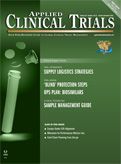PDUFA VI Promotes Patient Views, Innovative Trials
Applied Clinical Trials
FDA and industry have agreed on a set of recommendations for revising the drug user fee program, which now sits before Congress as U.S. election nears.
FDA officials and industry leaders have agreed on a set of recommendations for revising and updating the Prescription Drug User Fee Act, with an emphasis on including patient views more systematically into the process for evaluating and vetting innovative therapies. A main theme of the PDUFA VI “commitment letter” is to support development of breakthrough therapies and treatments for rare diseases by conducting public workshops that lead to guidances on collecting patient input on disease burden, treatment impact and clinical outcomes assessments most important to patients.
This emphasis on hearing the patient voice also aims to encourage innovative clinical trial designs. The program calls for advancing clinical trial simulation approaches and to expand use of adaptive, Bayesian and other novel trial designs to support model-informed drug development approaches.
A related initiative is to make greater use of real-world evidence (RWE) in evaluating efficacy during the approval process, as well as in tracking safety issues postapproval. PDUFA VI expands FDA’s Sentinel system for monitoring drug safety and emphasizes the need to update benefit-risk assessment in drug development and postmarket evaluation.
Improved FDA oversight of combination products is another new goal. The program calls for expanding staff and promoting more coordination between the Office of Combination Products and review centers for drugs, biologics and medical devices. Fee revenues will support additional reviewers for these complex products, development of guidances on bridging studies and labeling, clarification of protocols for human factors studies and an independent outside evaluation of the combination program.
New fees, operations
These and other initiatives will be supported by a significantly revised PDUFA fee structure that sponsors and FDA officials hope will make payments more predictable for all parties and create a more sustainable and manageable program. The current $2 million-plus fee for filing an NDA or BLA may drop somewhat, as a new “program” fee provides more of PDUFA revenues. This fee replaces current levies on manufacturing facilities and products and will be based on the number of approved drugs and biotech therapies marketed by a firm. Program fees will be calculated to yield 80% of the anticipated $1.2 billion collected by PDUFA in 2018, while application fees will support only 20% of program costs, thus reducing FDA’s reliance on revenues that can vary from year to year. But to avoid discouraging development of personalized therapies that may have five, 10 or more different formulations of the same product, a sponsor will have to pay the program fee for a maximum of five versions of the same drug.
Another notable change is to drop user fees altogether for efficacy and manufacturing supplements. The new policy doesn’t reduce FDA fee revenues that much and could prompt sponsors to update labeling more often and more quickly. The revised fee program also encourages manufacturers to submit full information on the facilities where a new therapy will be produced by stipulating that an approval goal date can be delayed by two or three months if the initial submission fails to list all planned manufacturing sites.
PDUFA VI further supports improvements in certain FDA operations and programs. An important initiative is to make the agency’s electronic submission process more transparent and more predictable, with clear time frames for document uploads and support for advancing data standards.
New strategies aim to keep staffers from drowning in meetings. While agency officials encourage sponsors to meet early and often with reviewers to discuss and gain agreement on product development plans and protocols, these efforts have overwhelmed CDER and CBER with some 3,000 meeting requests in 2015. Agency officials seek to improve the process by resolving some issues in writing, instead of in-person meetings, and to gain more time to review the often thousands of pages of background documents prior to a meeting.
An important provision of PDUFA VI aims to improve FDA’s hiring process to help bring more scientists and medical professionals into the agency. New procedures would clarify and simplify job announcements, and a new high-level agency office will oversee recruitment and retention of scientific staff. Agency expertise is critical, stakeholders agree, for FDA to meet the many goals and challenges of the PDUFA program.
FDA and industry worked hard to gain agreement on PDUFA VI fairly quickly and are looking for broad support from patients and the medical community to spur Congressional consideration of the revised program. The legislators need to reauthorize FDA fees for drugs and biologics, along with similar programs for biosimilars, medical devices and generic drugs, before they expire Sept. 30, 2017. The pressure is on because a change in administration in January will delay Congressional consideration of new programs and policies for several months.

FDA Fast Tracks Johnson & Johnson’s Nipocalimab for Fetal Neonatal Alloimmune Thrombocytopenia
March 27th 2024Johnson & Johnson is moving forward with a pair of Phase III trials of nipocalimab to reduce the risk of fetal neonatal alloimmune thrombocytopenia in alloimmunized pregnant patients.